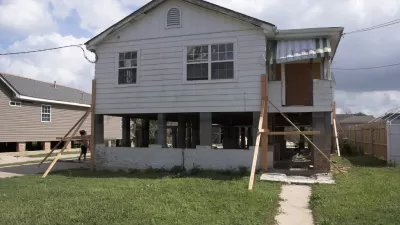Risk-management experts are seeking creative ways to finance resilience investments that prevent damage from natural disasters. Insurance markets, with their direct stake in protecting homes and businesses, can be key partners in this effort.
Broadly speaking, the world of insurance can be divided into two different sectors: private insurance companies and government-run programs. In the United States, the latter have long enticed policyholders to embrace resilience through a simple reward system: make risk-reducing upgrades to your building, and we’ll lower your insurance rates. This mechanism underlies much of the thinking about the power of insurance markets to drive resilience investments. Consider the National Flood Insurance Program (NFIP), America’s federal flood-insurance provider. Established in 1968, and today administered by the Federal Emergency Management Agency (FEMA), the NFIP partners with more than 80 private insurers to provide insurance to property owners if their communities agree to adopt ordinances that reduce the risk of flooding. For the NFIP, measures such as elevating the lowest floor above the base flood elevation qualify homeowners for reduced rates. Strategies like these can be hugely effective. As detailed in a 2015 report by the nonprofit Enterprise Community Partners, one multifamily building in Hoboken, New Jersey, installed floodwater vents and elevated the first floor to ground level. The $25,000 retrofit reduced the cost of flood insurance by 83%, with a return on investment of less than three years. (The owner originally paid $12,000 for $300,000 worth of coverage; after the retrofit, the premium dropped to $2,000 for $820,000 worth of coverage.)
FULL STORY: Can insurance markets jump start resilience?

Montreal Mall to Become 6,000 Housing Units
Place Versailles will be transformed into a mixed-use complex over the next 25 years.

Planetizen Federal Action Tracker
A weekly monitor of how Trump’s orders and actions are impacting planners and planning in America.

California High-Speed Rail's Plan to Right Itself
The railroad's new CEO thinks he can get the project back on track. The stars will need to align this summer.

Tenant Advocates: Rent Gouging Rampant After LA Wildfires
The Rent Brigade says it's found evidence of thousands of likely instances of rent gouging. In some cases, the landlords accused of exploiting the fires had made campaign donations to those responsible for enforcement.

Seattle’s Upzoning Plan is Ambitious, Light on Details
The city passed a ‘bare-bones’ framework to comply with state housing laws that paves the way for more middle housing, but the debate over how and where to build is just getting started.

DOJ Seeks to End USDOT Affirmative Action Program
The Disadvantaged Business Enterprise Program encouraged contracting with minority- and women-owned businesses in the transportation sector, where these groups are vastly underrepresented.
Urban Design for Planners 1: Software Tools
This six-course series explores essential urban design concepts using open source software and equips planners with the tools they need to participate fully in the urban design process.
Planning for Universal Design
Learn the tools for implementing Universal Design in planning regulations.
City of Camden Redevelopment Agency
City of Astoria
Transportation Research & Education Center (TREC) at Portland State University
City of Camden Redevelopment Agency
Municipality of Princeton (NJ)
Regional Transportation Commission of Southern Nevada





























